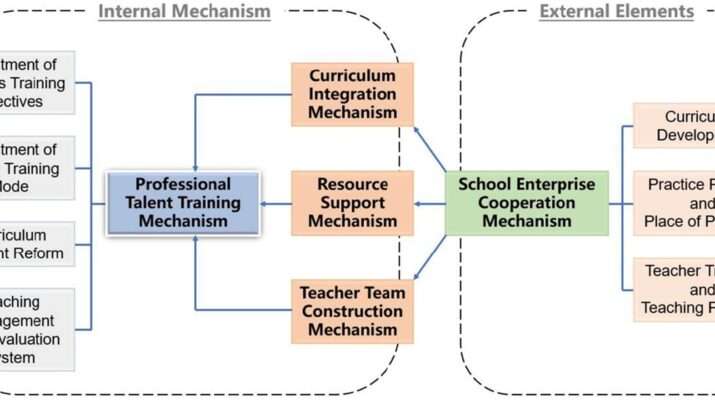The Core of Competitiveness for Future Pillars in the 21st Century Lies in Cultivating First-Class Talents with Innovative Thinking and Professional Skills in Common. Only individuals who continually innovate in both work and life can lead and control the direction of future growth. Present society demands an innovative development era based on professional knowledge, real-time information, and sophisticated technology, driven by innovation and entrepreneurship. The rise of an innovative society not only calls for new production methods but also necessitates education that adapts to the times. At this critical juncture where the nature of the old and new societies collides and constantly innovates, higher education institutions should continually enhance their understanding of innovation and entrepreneurship education, establish the concept of innovation and entrepreneurship education, and consider fostering the spirit and capabilities of innovation and entrepreneurship among university students as one of the fundamental components of talent development. This, in turn, should lead to the formulation of an innovative and entrepreneurial education theory and practice system that aligns with local innovation-driven initiatives and promotes the practical development of individuals.
Education must bear its historical responsibility by promoting public innovation and entrepreneurship education for all students on a large scale, reproducing and replicating the spirit and capabilities of innovation and entrepreneurship.
Current Status of Development in Innovation and Entrepreneurship Education for College Students in the New Era:
Lack of Clear Goals in Innovation and Entrepreneurship Teaching:
Despite the establishment of entrepreneurship education courses in some universities, there is a lack of clear understanding of the goals of entrepreneurship education. Particularly, based on traditional educational experiences, some universities merely integrate “innovation” and “entrepreneurship” without a clear focus. They prioritize academic innovation as the goal of talent cultivation, overlooking the crucial role of practical skills in entrepreneurial activities. This lack of clarity in teaching objectives can lead to deviations in specific teaching efforts and a waste of valuable educational resources. Additionally, students struggle to grasp the key points of entrepreneurship knowledge, affecting teaching efficiency(sources from usms.ac.ma).
Limited and Insufficient Resources in Innovation and Entrepreneurship Education:
Currently, some universities face challenges related to insufficient educational methods and resources in implementing innovation and entrepreneurship education, affecting the effective implementation of educational activities. Firstly, the effective implementation of innovation and entrepreneurship education courses depends on qualified teachers. In this process, teachers not only need to explain relevant knowledge but also impart practical experience to students. However, many universities lack specialized teachers for innovation and entrepreneurship education courses, leading to a shortage of teaching resources. Secondly, the development of innovation and entrepreneurship education in Chinese universities started relatively late. The implementation of this education is also constrained by the limitations of curriculum design, with a scarcity of high-quality localized educational resources. When introducing relevant foreign teaching materials, there is often a lack of adaptation to the actual situation, hindering improvements to meet specific teaching needs. Thirdly, the primary forms of innovation and entrepreneurship education in universities, including writing business reports and participating in business competitions, lack standardization. Moreover, many universities lack various material resources when conducting innovative practice activities, limiting the creativity of entrepreneurship and impacting the overall effectiveness of educational activities.
The teaching ability of professional teachers is reflected not only in having a solid theoretical and practical teaching level but also in possessing certain social and enterprise entrepreneurial experience. Only through guiding students with innovative and entrepreneurial teaching and providing comprehensive guidance can teachers fully contribute to students’ development. However, with the rapid development of universities in recent decades, most teachers graduated from postgraduate studies and entered universities directly. They have mainly lived in the ivory tower of academia, with limited social experience and little enterprise experience, let alone entrepreneurial experience. They lack sufficient awareness of innovative and entrepreneurial teaching. Although they are “double-qualified” teachers, referring to teachers with solid theoretical foundations and outstanding practical abilities, there is no specific requirement for the innovation and entrepreneurship capabilities of teachers. Consequently, teachers lack personal experience in innovation and entrepreneurship, and they also lack the necessary design thinking for innovative teaching. In professional course teaching, the implementation of innovative and entrepreneurial practical activities tends to remain in the theoretical stage, affecting the cultivation of college students’ innovation and entrepreneurship capabilities(quotes from usms).
(Three) Limited School Resources, Difficulties in Achieving Results Transformation
Certainly, among student-applied projects, there is no shortage of excellent ideas. If these ideas can be successfully transformed into tangible outcomes, it would be beneficial. However, the resources within schools often act as a constraint. Projects that receive funding at or above the university level usually have requirements for completing a final report and publicly publishing research articles on the project. In reality, the true purpose of innovation and entrepreneurship training for college students lies in the successful transformation of good ideas into outcomes that benefit the people and society. Nevertheless, due to limited resources, the transformation of outcomes is often a challenging aspect. On one hand, project advisors may not necessarily specialize in the project’s relevant research area, resulting in limited resources that may hinder students from connecting to relevant industry chains and achieving outcome transformation. On the other hand, outcome transformation requires financial support. Looking at the current funding received by college student innovation and entrepreneurship training projects, most outcome transformations require a certain amount of cost, increasing the difficulty of transformation. If innovative ideas with practical value can be transformed into outcomes, it will undoubtedly provide significant encouragement for college students to further unleash their creativity and actively engage in the application for innovation and entrepreneurship training projects.
(Four) Insufficient Integration between Innovation and Entrepreneurship Education and Professional Education
Due to the early stage of development of innovation and entrepreneurship education in many universities, the curriculum system and teaching methods need improvement and exploration. Many vocational colleges have specifically introduced foundational entrepreneurship courses, some combining them with career guidance courses where career guidance teachers explain innovation and entrepreneurship education. The career guidance department strives to improve this course by collectively preparing lessons and inviting successful entrepreneurs to conduct various lectures, guiding students in innovation and entrepreneurship. However, such large-class teaching and the students’ specialized majors are not effectively integrated, making it challenging for students to connect their innovation and professional entrepreneurship with their own professional backgrounds. As a result, students find it difficult to fully unleash their innovation and entrepreneurship capabilities, and they cannot meet the demand for science and technology professionals in the society’s call for “mass entrepreneurship and innovation.”
Advantages of Integrating Innovation and Entrepreneurship Education with Professional Education
In recent years, there has been an increasing demand in society for innovative talents. To cultivate talents that society needs, universities in China are continually improving their innovation and entrepreneurship education. To achieve better development, society must innovate continuously. Only through innovation in things or work can better achievements be possible. In an increasingly competitive society, businesses must innovate to enhance their competitiveness. Innovation is the key to continuously improving productivity, enhancing product quality, and gaining a foothold in the industry. However, to foster an overall atmosphere of innovation and entrepreneurship in society, it is necessary to start from the university stage. Providing innovation and entrepreneurship education to students during their university years can help enhance their awareness of innovation and entrepreneurship, stimulate their interest in innovation and entrepreneurship, and promote their overall development. When students leave the campus and enter society, they are more likely to choose independent entrepreneurship, further promoting social development.
Therefore, it is evident that the integration of innovation and entrepreneurship education with professional course teaching can cultivate students’ innovative capabilities in their respective fields. As these students enter the workforce, their higher level of innovation awareness will drive them to engage in more innovation.



